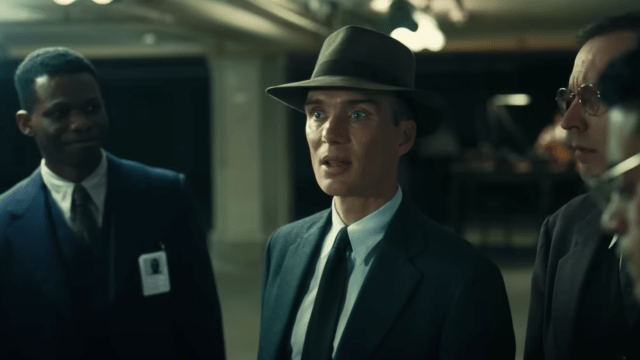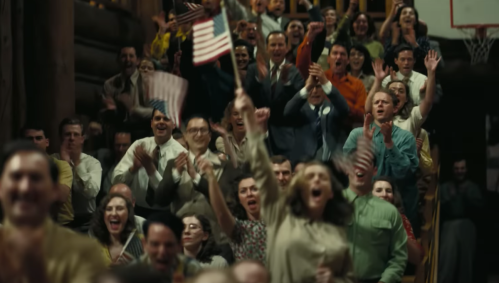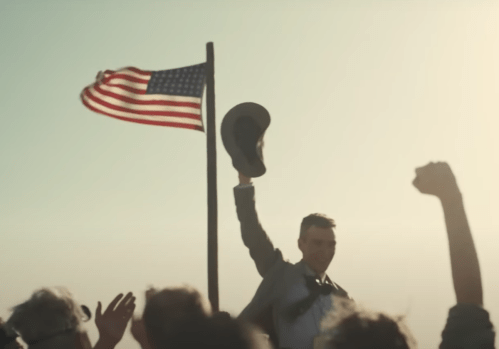Major Historical Inaccuracy in “Oppenheimer” Spotted by Fan

After much anticipation, “Barbenheimer” weekend finally arrived on July 21. Last Friday, both Barbie and Oppenheimer, two of the most anticipated films of the summer, hit theaters around the world. The buzz around both films made for one of the biggest opening weekends of all time. Greta Gerwig’s take on the Mattel toy universe and Christopher Nolan’s adaptation of the life of the “father of the atomic bomb” also generated a lot of conversation—both positive and negative—in addition to box office dollars. In the case of Oppenheimer, some viewers noticed a mistake in the background of one scene that is actually a major historical inaccuracy. Read on to find out what they spotted, why it’s out of place, and why some fans are arguing that it might be there on purpose.
RELATED: 7 Oscar-Winning Movies That Are Offensive by Today’s Standards.
Oppenheimer spans several decades.
Oppenheimer tells the story of J. Robert Oppenheimer (Cillian Murphy), the nuclear physicist who was key to the creation of the atomic bomb. It follows him as a student in the ’20s, leading the team of scientists creating the bomb in the ’40s, and during post-World War II government hearings in the ’50s.
A scene in the ’40s stood out to eagle-eyed audience members.

As reported by CNN, a scene that takes place in 1945 stood out to some viewers because of the flags some attendees of a rally at which Oppenheimer is speaking are waving. These flags include 50 stars and are therefore the U.S. flag that we still use today.
The problem is, in 1945, the U.S. consisted of only 48 states. From 1912 until 1959, when Alaska was granted statehood, the 48-starred flag was in use. Hawaii also became a state the same year, but the 50-star flag was not displayed for the first time until 1960. That means, that while many other aspects of Oppenheimer are accurate to the periods in which it’s set, this one is not.
For more celebrity news delivered right to your inbox, sign up for our daily newsletter.
Oppenheimer fans discussed the gaffe on Twitter.
Twitter user Andy Crag is being credited with drawing attention to the mistake. His tweet about the flag flub has over 50K likes.
“It was good and all, but I’ll be that guy and complain they used 50-star flags in a scene set in 1945,” @AndrewRCraig wrote.
Another Twitter user responded, “Hold on…I’m counting. lol” to which Craig replied, “No need! The pattern’s different. Staggered rows vs. grid arrangement.”
Some people pointed out that a historically accurate (and larger) American flag is used in a different scene. “The big giant flag in the scene where oppenheimer gets lifted on the crowds shoulders after the test uses the correct flag,” someone else tweeted. “Bigger/more important set piece means they paid more attention to it. my guess is they didnt care enough to have specially made tiny flags, just the big one.”
Others couldn’t believe that the inaccuracy made it into the final cut. “Imagine being paid a hefty amount of money to be the Set dresser for Oppenheimer and using the wrong flags for the time period in a HISTORICAL PIECE MOVIE,” someone posted in response to Craig’s tweet.
Some argued that the “mistake” was purposeful.

Some Twitter users theorized that the 50-star flag was used on purpose to support the interpretation that certain scenes were being told from Oppenheimer’s memory rather than as they actually happened.
“I doubt it was a mistake,” someone tweeted. “Those scenes were from Oppenheimer’s memory, which was subjective. The scene after the initial project is complete features the correct flag, so the film makers were well aware that the flag was different during that time period.”
Another person posted, “personally i think it was done intentionally, because coloured scenes were from oppenheimer’s perspective which is his present day’s memory that was after the 50-star flag was established.”
Someone else said, “The issue going on about the flag is totally wrong. Nolan already stated that the colored scenes are subjective. He purposefully kept it there. Its not a mistake. Some of y’all need some basic education in general.”
RELATED: 6 ’90s Movies You Can’t Watch Anywhere Now.
Nolan explained why some scenes are black and white and others are in color.

As that flag-defending tweet stated, director Christopher Nolan did talk about the story being “very subjectively” told in an interview with Total Film. Although, he did not indicate whether Oppenheimer’s subjective version of events would include things like subtle flag inaccuracies. Instead, the Interstellar filmmaker explained why he shifted from black and white to color to separate the subjective and the objective.
“I very much loved the structural assistance and the aesthetic charge of shifting between color and black and white that I had on Memento,” he said, referencing his 2000 film. “I’d always been looking for a reason to go back to that. And in the case of Oppenheimer and the way in which we tell this story, it’s very subjectively [told], but also with a more objective story strand that intertwines with that. It was really the perfect time to go back to that device that I loved so much.”